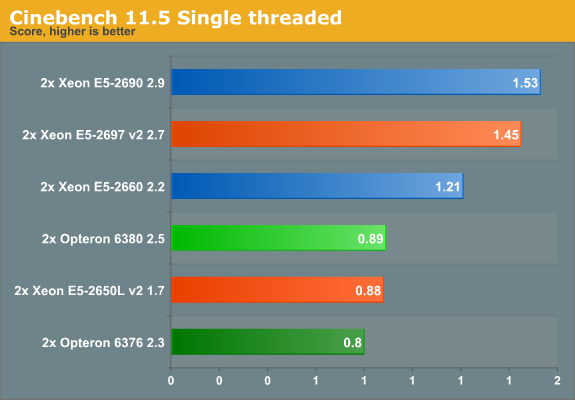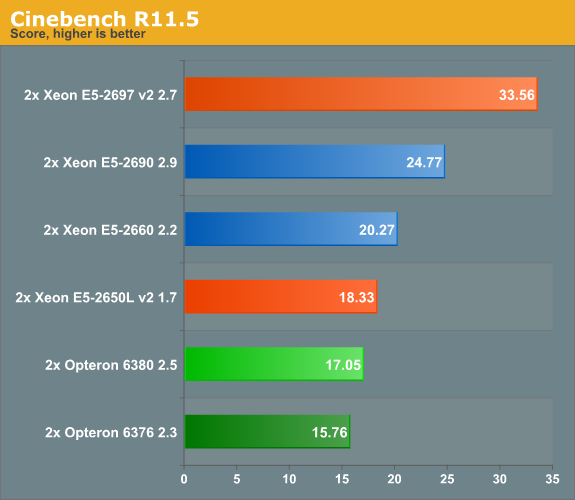Intel's Xeon E5-2600 V2: 12-core Ivy Bridge EP for Servers
by Johan De Gelas on September 17, 2013 12:00 AM ESTRendering Performance: Cinebench
Cinebench, based on MAXON's CINEMA 4D software, is probably one of the most popular benchmarks around as it is pretty easy to perform this benchmark on your own home machine. The benchmark supports up to 64 threads, more than enough for our 24- and 32-thread test servers. First we test single-threaded performance, to evaluate the performance of each core.

Cinebench achieves an IPC between 1.4 and 1.8 and is mostly dominated by SSE2 code. There is little improvement in that area, and the older 2.9-3.8GHz E5-2690 has the clock speed advantage over the new 2.7-3.5GHz E5-2697 v2. Also of note is that i n this type of code, one Piledriver core again needs 50% higher clock speed to keep up with the Ivy Bridge core.

Once we run up to 48 threads, the new Xeon can outperform its predecessor by a wide margin of ~35%. It is interesting to compare this with the Core i7-4960x results , which is the same die as the "budget" Xeon E5s (15MB L3 cache dies). The six-core chip at 3.6GHz scores 12.08. It is clear that chosing cores over clock speed is a good strategy in rendering farms: the dual E5-2650L offers 50% better performance in a power budget that is more or less the same (2x70W vs 130W).










70 Comments
View All Comments
ShieTar - Tuesday, September 17, 2013 - link
Oops, you are perfectly right of course. In that case the 4960X actually gets the slightly better efficiency (12.08 is 0.28 per thread and GHz) than the dual 2697s (33.56 is 0.26 per thread and GHz), which makes perfect sense.It also indicates the 4960X gets about 70% of the performance of a single 2697 at 38% of the cost. Then again, a 1270v3 gets you 50% of the performance at 10% of the price. So when talking farms (i.e. more than one system cooperating), four single-socket boards with 1270v3 will get you almost the power of a dual-socket board with 2697v2 (minus communication overhead), will likely use similar power demand (plus communication overhead), and save you $4400 in the process. Since you use 32 instead of 48 threads, but 4 installations instead of 1, software licensing cost may vary strongly in either direction.
Would be interesting to see this tested. Anybody willing to send AT four single-socket workstations?
hpvd - Tuesday, September 17, 2013 - link
yes - this would be really interesting. But you should use Infiniband interconnect for a good scaling. And this could only be done without an expensive IB-Switch with 3-maschines...DanNeely - Tuesday, September 17, 2013 - link
Won't the much higher price of a 4 socket board kill any CPU cost savings?In any event, the 1270v3 is a unisocket chip so you'd need to do 4 boxes to cluster.
Poking around on Intel's site it looks like all 1xxx Xeons are uniprocessor, 2xxx is dual socket, 4xxx quad, 8xxx octo socket. But the 4xxx series is still on 2012 models and 8xxx on 2011 releases. The 4 way chips could just be a bit behind the 2way ones being reviewed now; but with the 8 way ones not updated in 2 years I'm wondering if they're being stealth discontinued due to minimal cases where 2 smaller servers aren't a better buy.
hpvd - Tuesday, September 17, 2013 - link
I think we are talking around about 4 systems with each one cpu, one mainboard, RAM, ..+ network interface cardhpvd - Tuesday, September 17, 2013 - link
another advantage would be that these CPUs uses the latest Hashwell Achitecture: some workloads would greatly benefit from it's AVX2 ...Kevin G - Tuesday, September 17, 2013 - link
I'd fathom the bigger benefit of Haswell is found in the TSX and L4 cache for server workloads. The benefits of AVX2 would be exploited in more HPC centric workloads. Now if Intel would just release a socketed 1200v3 series CPU with L4 cache.MrSpadge - Tuesday, September 17, 2013 - link
> Now if Intel would just release a socketed 1200v3 series CPU with L4 cache.Agreed! And someone would test it at server loads. And BOINC. And if only Intel would release an overclockalbe Haswell with L4 which we can actually buy!
ShieTar - Tuesday, September 17, 2013 - link
A 4 socket board is expensive, but thats not the discussion I was making. A Xeon E5-4xxx is not likely to be less expensive than the E5-2xxx part anyways.The question was specifically how four single socket boards (with 4 cores each, at 3.5GHz, and Haswell technology) would position themselves against a dual-socket board with 24 cores at 2.7GHz and Ivy Bridge EP tech. Admittedly, the 3 extra boards will add a bit of cost (~500$), and and extra memory & communications cards, etc. can also add something depending on usage scenario. Then again, a single 4-core might get the work done with less than half the memory of a 12-core, so you might safe a little there as well.
psyq321 - Tuesday, September 17, 2013 - link
E5-46xx v2 is coming in few months, qualification samples are already available and for all intents and purposes it is ready - Intel just needs to ramp-up production.E7-88xx v2 is coming in Q1 2014, it is definitely not discontinued, and the platform (Brickland) will be compatible with both Ivy Bridge EX (E7-88xx v2 among others) and Haswell EX (E7-88xx v3 among others) CPUs and will also be able to take DDR4 RAM. It will require different LGA 2011 socket, though.
EX platform will come with up to 15 cores in Ivy Bridge EX generation.
Kevin G - Tuesday, September 17, 2013 - link
The E5-46xxx is simply a rebranded E5-26xx with official support for quad socket. The dies are the going to be the same between both families. Intel is just doing extra validation for the quad socket market as the market tends to favor more reliability features as socket count goes up.While not socket compatible, Brickland as a platform is expected to be used for the next (last?) Itanium chips.